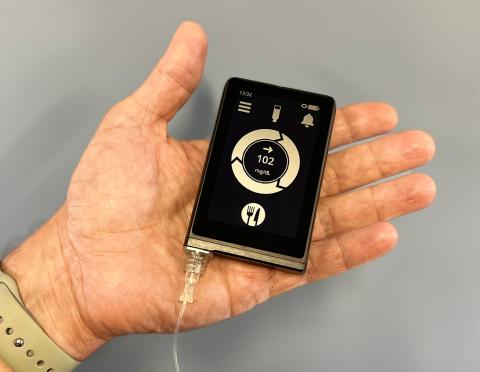Bionic Pancreas Improves Type 1 Diabetes Management

Photo: Beta Bionics
A device known as a bionic pancreas, which uses next-generation technology to automatically deliver insulin, was more effective at maintaining blood glucose (sugar) levels within normal range than standard-of-care management among people with type 1 diabetes. Results of this multicenter clinical trial, primarily funded by NIDDK, were published in the New England Journal of Medicine.
Automated insulin delivery systems, also called artificial pancreas or closed-loop control systems, track a person’s blood glucose levels using a continuous glucose monitor and automatically deliver the hormone insulin when needed using an insulin pump.
Compared to other available artificial pancreas technologies, the bionic pancreas requires less user input and provides more automation because the device’s algorithms continually adjust insulin doses automatically based on users’ needs. Users initialize the bionic pancreas by entering their body weight into the device’s dosing software at the time of first use.
Users of the bionic pancreas also do not have to count carbohydrates, nor initiate doses of insulin to correct for high blood glucose. In addition, health care providers do not need to make periodic adjustments to the device settings.
“Keeping tight control over blood glucose is important in managing diabetes and is the best way to prevent complications like eye, nerve, kidney and cardiovascular disease down the road,” said Dr. Guillermo Arreaza-Rubín, director of NIDDK’s diabetes technology program. “The bionic pancreas technology introduces a new level of ease to the day-to-day management of type 1 diabetes, which may contribute to improved quality of life.”
The 13-week trial, conducted at 16 clinical sites across the country, enrolled 326 participants ages 6 to 79 years who had type 1 diabetes and had been using insulin for at least one year. Participants were randomly assigned to either a treatment group using the bionic pancreas device or a standard-of-care control group using their personal pre-study insulin delivery method.
In participants using the bionic pancreas, glycated hemoglobin, a measure of a person’s long-term blood glucose control, improved from 7.9 percent to 7.3 percent, yet remained unchanged among the standard-of-care control group. The bionic pancreas group participants spent 11 percent more time, approximately 2.5 hours per day, within the targeted blood glucose range compared to the control group. These results were similar in youth and adult participants. Improvements in blood glucose control were greatest among participants who had higher blood glucose levels at the beginning of the study.
The study is one of several pivotal trials funded by NIDDK that is providing safety and efficacy data needed for regulatory review and licensure to make the technology commercially available.
NIDDK director Dr. Griffin P. Rodgers said, “While we continue to search for a cure for type 1 diabetes, devices like the bionic pancreas can allow people to worry less about their blood-glucose levels and focus more on living their fullest, healthiest lives.”
